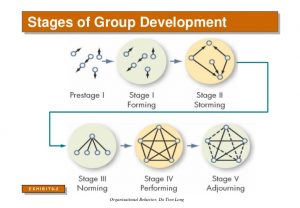Over the semester, I work with my assigned group members to examine, analyze, and solve a movie case which involves management issues. While we dedicated our time to solve the problem, we ourselves are also a live case on teamwork. Using the Five-Stage Model of Group Development, I would now reflect on the establishment and functioning of my case project group.
Our group, though not the energetic, hyper type of group, had formed well in the initial stages (Forming and Storming). We treated each other with respect, and we talked to each other in a friendly manner. Having just mentioned that, I noticed that my group members have differing personalities: Some of us were task-oriented and valued efficiency over effectiveness, while others were creative and would like to explore a variety of ideas before jumping into the work process. I was the latter type of person, and since the harmony within groups is important, I tried to present my ideas in a more timely manner so that creativity and efficiency co-existed.
As the deadlines of the project drew near, some issues emerged in the norming stage. Although the team structure was solidified, it was not an interactive group. We did not establish a norm of challenging each other’s ideas, and as a result groupthink influenced our performance. It is usually easier for tired university students to focus on “getting the job done,” however, this mentality can hinder growth and the potential of project. Also, I agree with the point brought up by Homen that different expectations on the result of the project will lead to the deviation of commitment among group members. The person who aims for a perfect outcome will inevitably contribute more on the project, and the workload will never be even.
Additionally, our group did not establish a habit of communication. We were concerned about the effect of our suggestions on our relationships with each other, and thus we rarely directly pointed out how each member can improve on their performance.
Finally, our group performed adequately in the case report and presentation. Although there are issues in our group, we have made large progress in finishing the job. We practiced hard for the presentation, and the final effort lead to a satisfying outcome.
Word Count: 396
Work Cited:
Langton, N., Robbins, S. P., & Judge, T. (2006). Organizational behaviour: Concepts, controversies, applications (4th Canadian ed.). Toronto: Pearson Canada.

Recent Comments